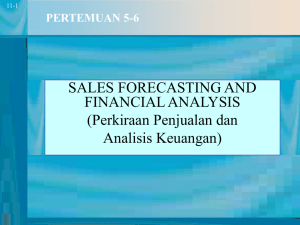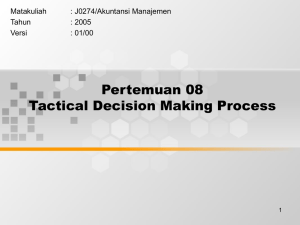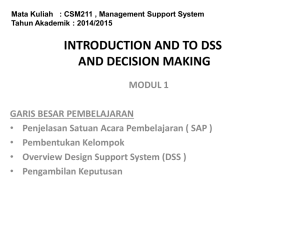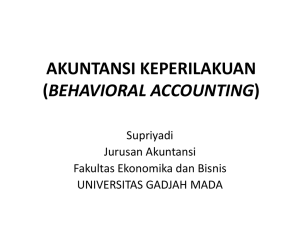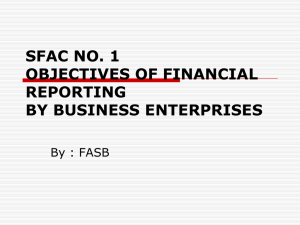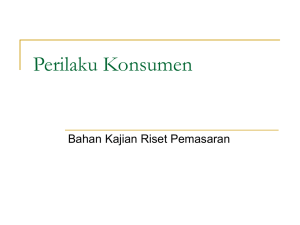Decision Making - Binus Repository
advertisement
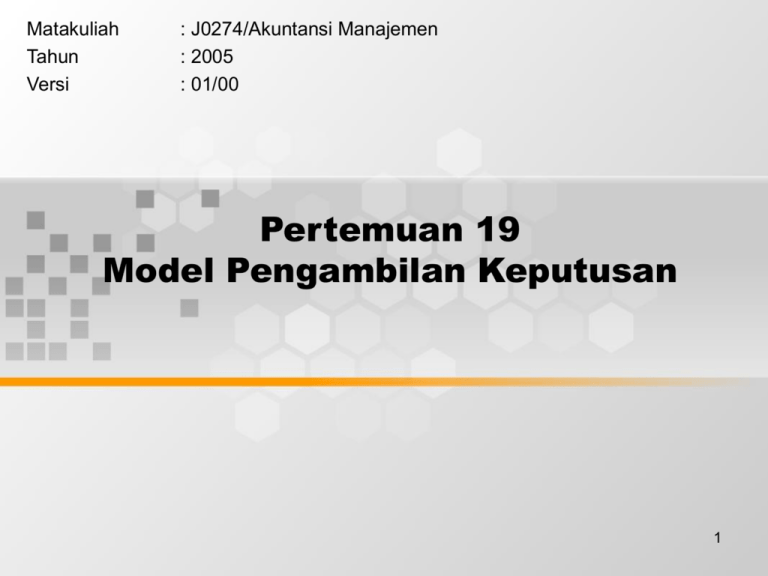
Matakuliah Tahun Versi : J0274/Akuntansi Manajemen : 2005 : 01/00 Pertemuan 19 Model Pengambilan Keputusan 1 Learning Outcomes Pada akhir pertemuan ini, diharapkan mahasiswa akan mampu : • Memahami proses pengambilan keputusan termasuk aspek-aspek yang mempengaruhi proses 2 Outline Materi • • • • Informas sebagai barang ekonomi Sifat dan tipe keputusan Model pengambilan keputusan Tahapan pengambilan keputusan 3 Informasi sebagai suatu barang ekonomi • Rantai transformasi: – DATA - INFORMATION - KNOWLEDGE -- WISDOM • Informasi adalah sebuah special good – – – – – Biaya produksi tinggi Biaya reproduski quasi null Biaya tetap tinggi, namun biaya marjinal rendah Nilai informasi (waktu, volume, ketidakpastian) Harga Jual informasi tergantung pada nilai/manfaat, bukan pada biaya. Sifat Dasar Decision Making • Pengambilan Keputusan – Adalah tindakan memilih salah satu alternatif dari sekumpulan alternatif yang tersedia. • Proses Pengambilan Keputusan – Rangkaian Proses mengenali, mendefinisikan situasi, identifikasi alternatif, memilih alternatif terbaik, dan implementasinya. – Sebuah keputusan yang efektif adalh yang mengoptimalkan beberapa faktor seperti laba, penjualan, kesejahteraan karyawan dan pangsa pasar. – Para manajer membuat keputusan berkenaan dengan masalah dan kesempatan. 5 Tipe Keputusan • Keputusan Terprogram – Suatu Keputusan yang cukup terstruktur (recurs) yang kerap berulang. • Contoh : Memanaskan mesin mobil di pagi hari. • Keputusan Tak terprogram – Suatu keptusan yang relatif dan terstruktur dan terjadi sangat jarang dibandingkan keputusan teprogram. • Contoh: Memilih tujuan wisata saat liburan. 6 Tipe Keputusan • Routine and Non-Routine Decisions • Objective vs. Bounded Rationality • Level of Certainty 7 Kondisi Decision-Making • Decision Making Under Certainty – Suatu kondisi dimana manajer memahami dengan baik alternatif yang tersedia serta kondisi berkaitan dengan setiap alternatif. • Decision Making Under Risk – Suatu kondisi berkenaan dengan ketersediaan alternatif dan potensi manfaat serta biaya resiko. • Decision Making Under Uncertainty – Suatu kondisi dimana manajer tidak mengetahui seluruh alternatif, resiko setiap alternatif, atu konsekuensi untuk setiap alternatif. 8 Uncertainty apa saja yang ada? • Uncertainty karena Teknologi – Dell and LiOn battery – Will it work? Will Sony as the only supplier have enough capacity? • Uncertainty berkenaan permintaan – Economic recession or boom, interest rates, inflation, consumer preferences – Expansion of Saturn’s Spring Hill Plant • Uncertainty karena persaingan – Competitive actions and reactions – Success of international expansion by Wal-Mart – Success of new beverages of Coke and Pepsi 9 Isu lainnya dalam Decision Making Incentives for Decision Makers Short-Run Versus Long-Run Decisions 10 Isu lainnya dalam Decision Making Pitfalls yang harus dihindari Sunk costs. Allocated fixed costs. Unitized fixed costs. Opportunity costs. 11 Kondisi Decision-Making Kondisi yg dihadapi manajer... Certainty Risk Uncertainty Level of ambiguity and chances of making a bad decision Lower Moderate Higher 12 Pandangan Rasional dalam Decision Making • Model Klasik Decision Making • obtain complete When faced with a and perfect information decision situation, • eliminate uncertainty managers should. . . • evaluate everything rationally and logically . . . and end up with a decision that best serves the interests of the organization. 13 Figure 9.2 Langkah Dasar Rational Decision Making 1. Identifikasi seluruh opsi (termasuk doing nothing). 2. Kuantifikasi nilai (biaya) konsekuensi yang mungkin timbul untuk setipa opsi 3. Prediksi likelihood untuk setiap konsekuensi. 4. Integrasi seluruh kemungkinan. 14 Kompenen Decision Making • State /Kondisi – Adalah kondisi aktual yang mungkin terjadi di masa mendatang • Keputusan / Decision – Berbagai pilihan dimana seorang decision maker dapat memilih satu diantaranya • Outcomes /hasil – Hasil dari suatu kombinasi states dan decisions 15 Tahapan menuju Good Decisions • • • • Definisikan problem dan influencing factors Tetapkan decision criteria Pilih model pengambilan keputusan Identifikasi dan evaluasi alternatif menggunakan model yang dipilih • Pilih alternatif terbaik • Implementasi keptusan • Evaluasi hasil 16 Models • Memungkinkan manajer melakukan analisis “What if”. • Disusun untuk manajemen masalah dan manajemen input • Force a consistent and systematic approach to the analysis of problems • Require managers to be specific about constraints and goals relating to a problem • Help reduce the time needed in decision making 17 Keterbatasan Models They • may be expensive and time-consuming to develop and test • are often misused and misunderstood (and feared) because of their mathematical and logical complexity • tend to downplay the role and value of nonquantifiable information • often have assumptions that oversimplify the variables of the real world 18 The Decision-Making Process Quantitative Analysis Problem Logic Historical Data Marketing Research Scientific Analysis Modeling Decision Qualitative Analysis Emotions Intuition Personal Experience and Motivation Rumors 19 Ways of Displaying a Decision Problem • Decision trees • Decision tables Outcomes States of Nature Alternatives Decision Problem 20 Steps in the Rational Decision-Making Process Step Detail Example 1. Recognizing and defining the decision situation Some stimulus indicates that a decision must be made. The stimulus may be positive or negative. A plant manager sees that employee turnover has increased by 5 percent. 2. Identifying alternatives Both obvious and creative alternatives are desired. In general, the more important the decision, the more alternatives should be considered. The plant manager can increase wages, increase benefits, or change hiring standards. 3. Evaluating alternatives Each alternative is evaluated to determine its feasibility, its satisfactoriness, and its consequences. Increasing benefits may not be feasible. Increasing wages and changing hiring standards may satisfy all conditions. 21 Table 9.1a Steps in the Rational Decision-Making Process (cont’d) Step Detail Example 4. Selecting the best alternative Consider all situational factors, and choose the alternative that best fits the manager’s situation. Changing hiring standards will take an extended period of time to cut turnover, so increase wages. 5. Implementing the chosen alternative The chosen alternative is implemented into the organizational system. The plant manager may need permission from corporate headquarters. The human resource department establishes a new wage structure. 6. Following up and evaluating the results At some time in the future, the manager should ascertain the extent to which the alternative chosen in step 4 and implemented in step 5 has worked. The plant manager notes that, six months later, turnover has dropped to its previous level. 22 Table 9.1b Evaluating Alternatives in the Decision-Making Process Is the alternative feasible? Yes Is the alternative satisfactory? Yes Are the alternative’s consequences affordable? No No No Eliminate from consideration Eliminate from consideration Eliminate from consideration Yes Retain for further consideration 23 Figure 9.3 Behavioral Aspects of Decision Making (cont’d) • Bounded Rationality – The concept that decision makers are limited by their values and unconscious reflexes, skills, and habits. • Satisficing – The tendency to search for alternatives only until one is found that meets some minimum standard of sufficiency to resolve the problem. • Coalition – A political force in decision making which consists of an informal alliance of individuals or groups formed to achieve a goal. 24 Behavioral Aspects of Decision Making (cont’d) • Intuition – An innate belief about something without conscious consideration. • Escalation of Commitment – A decision maker is staying with a decision even when it appears to be wrong. • Risk Propensity – The extent to which a decision maker is willing to gamble when making a decision. 25 Behavioral Aspects of Decision Making (cont’d) • Ethics and Decision Making – Individual ethics (personal beliefs about right and wrong behavior) combine with the organization’s ethics to create managerial ethics. – Components of managerial ethics: • Relationships of the firm to employees • Employees to the firm • The firm to other economic agents 26 Group and Team Decision Making in Organizations • Forms of Group Decision Making – Interacting groups or teams • are the most common form of decision-making groups which consists of an existing group or newly formed team interacting and then making a decision. – Delphi groups • are sometimes used for developing a consensus of expert opinion from a panel of experts who individually contribute through a moderator. – Nominal groups • are a structured technique designed to generate creative and innovative ideas through the individual contributions of alternatives that are winnowed down through a series of rank-ordering of the alternatives to reach a decision. 27 Advantages and Disadvantages of Group and Team Decision Making Advantages Disadvantages 1. More information and knowledge are available. 1. The process takes longer than individual decision making, so it is costlier. 2. More alternatives are likely to be generated. 3. More acceptance of the final decision is likely. 4. Enhanced communication of the decision may result. 2. Compromise decisions resulting from indecisiveness may emerge. 3. One person may dominate the group. 4. Groupthink may occur. 5. Better decisions generally emerge. 28 Table 9.2 Managing Group and Team Decision-Making Processes • Managers Can Promote the Effectiveness of Group and Team Decision Making – Being aware of the pros and cons of having a group or team make a decision. – Setting deadlines for when decisions must be made. – Avoid problems with dominance by managing group membership. – Have each group member individually critically evaluate all alternatives. – As a manager, do not make your position known too early. – Appoint a group member to be a “devil’s advocate.” 29 – Hold a follow-up meeting to recheck the decision.
